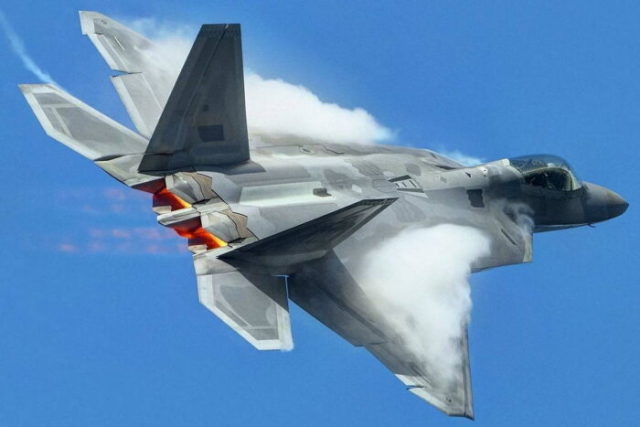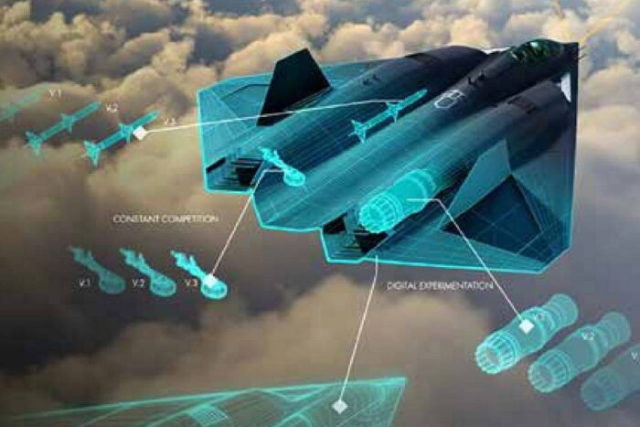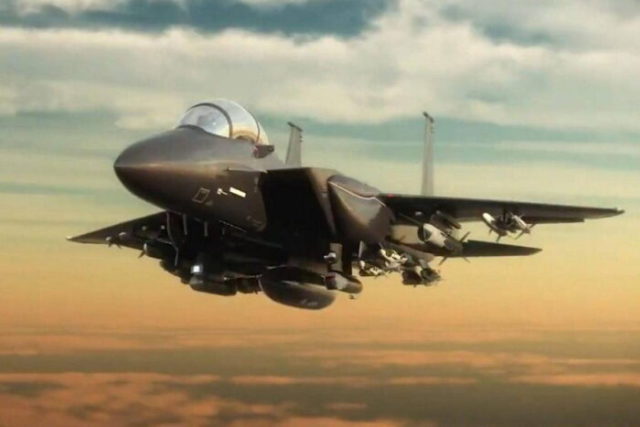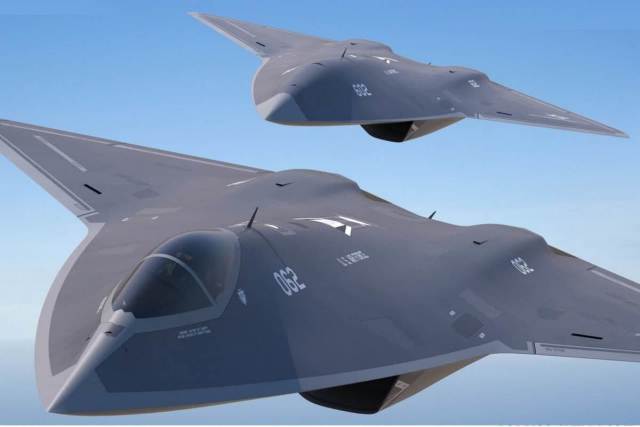Currently, the US Air Force is developing a Next-Generation tactical Air Dominance aircraft (NGAD) system. NGAD, or the 6th generation fighter. Eventually, it will replace the 5th generation F-22 RAPTOR as the U.S. Air Force's primary means of gaining air superiority. The European Security & Defense magazine has published a report on the status and prospects of the implementation of the American NGAD project. [The following translation of the article is made while preserving the style of the authors of the material]

The 5th generation F-22 Raptor fighter
The U.S. Air Force's Next-generation Air Dominance Program
The NGAD is often referred to as the next generation fighter, and even U.S. Air Force leaders tend to discuss it in such terms. Formally, the Pentagon describes NGAD as "a family of capabilities that provide air superiority in the most difficult operating conditions. (...) [NGAD] is an advanced aircraft engineering program for the development of penetrating anti–aircraft platforms with multi-domain situational awareness, flexible fault-tolerant communications and an integrated family of capabilities." It is expected that elements of space, cyber and electronic warfare will be integrated into the NGAD system.
Information Package
Details of NGAD's design, technology and objective capabilities will continue to remain classified for some time, but the Pentagon has made general statements. The family of systems will include manned and unmanned elements. The manned fighter located at the center of the NGAD system is likely to have the ability to operate in unmanned mode. The aircraft will have a longer range and payload capacity than the F-22 RAPTOR (which is not surprising, given the widespread criticism of the F-22's combat range without refueling). It is expected that unmanned aircraft with additional ammunition and sensors will accompany the manned fighter, which will significantly increase the combat power of a single departure.

NGAD concept from March 2021
What looks [above] like a computer screenshot was published in March 2021 as part of the latest biannual procurement report by the U.S. Department of the Air Force and has generated significant interest. The image shows a twin-engine aircraft with a mixed wing and an internal armament compartment (all this is not surprising for a 6th generation aircraft, which, as a rule, should be inconspicuous in all aspects). Despite initial hopes that the US Air Force could reveal details of the design of the future fighter, it remains unclear whether the illustration actually shows the current NGAD manned prototype. An image showing replacement alternative engines, chassis, and payload may simply illustrate an aspect of the digital design of the development program. Given the stated intention of the US Air Force to prevent future adversaries from getting an early idea of NGAD, the published image may even be intentionally misleading. Despite the secrecy, senior executives have provided some additional information in recent months. According to the Chief of Staff of the US Air Force, General Charles K. Brown Jr., being designed primarily as a fighter to gain air superiority, the NGAD will receive multi-purpose capabilities. Speaking before the House Armed Services Committee in June 2021, General Ch.Brown explained that this secondary capability would primarily allow the aircraft to defend against surface-to-air weapons, but would also provide "opportunities for the commanders of our aviation components and for the Combined Forces." Implying that the aircraft could carry out missions to strike ground targets if other resources were not available. This would reflect the mission profile of the F-22.
Retired General James Holmes, who led the United States Air Force Combat Aviation Command (USAF's Air Combat Command, hereinafter referred to as the TANK) until October 2020, announced in June 2021 that NGAD could eventually include two manned aircraft. One would be optimized for the European theater of operations. Presumably, it will have normal dimensions, have a fast turnaround cycle and be able to operate from a large number of temporary airfields of this theater. A larger and heavier version – with a longer flight range and payload – will be configured for theater in the Indo-Pacific region. In addition to this difference in theater-oriented requirements, some experts suggest that a larger, multi-engine aircraft similar to a light bomber could be equipped with directed energy weapons and patrol a larger segment of airspace in any theater, increasing the number of smaller manned aircraft and unmanned fighters armed with air-to-air missiles.long-range air.
An equal player
The new aircraft will play a prominent role in the dwindling fleet of the US Air Force (out of 4,000 tactical aircraft at the end of the Cold War, today the number of fighter aircraft of the US Air Force is about 2,000 units). Currently, the U.S. Air Force uses seven different types of tactical aircraft (including three variants of the F-15). Logistical considerations, including simplified expeditionary services, are a key element of the USAF's decision to reduce the future tactical fleet to four types of aircraft. The transition is scheduled for the 2030s. In addition to NGAD, the future fighter fleet will include: 5th generation F-35 (which will make up the army's backbone); F-15EX (potential purchase of 140-200 vehicles to replace current versions of the F-15 as a "bomb truck" capable of carrying a very large surface-to-surface payload and "surface-to-air"); and the F-16 (the US Air Force intends to upgrade its approximately 600 aircraft of the last block for use in multi-purpose operations by the mid-2040s) or its final low-cost replacement "Generation 4.5".

USAF F-15EX Fighter Jet
As a 6th-generation air superiority fighter, the NGAD is primarily designed to compete with similar aircraft and aircraft close to analogues. "We need to go beyond just the Russian threat, go beyond the basic European airspace ranges and go beyond the technologies of the 1980s and 1990s and destroy the mechanically scanned single-band sensor," General Mark KELLY, head of the LHC, said during an August interview with DefenseNews. "Thus, although Russia remains a threat, we now face new adversaries, greater distances in the Indo-Pacific region and a much wider use of the electromagnetic spectrum. This requires long-range capabilities that can recognize, film and operate successfully in a multispectral environment."
By fighting enemy air superiority fighters, NGAD will facilitate the operations of American and Allied attack aircraft and bombers. In this context, the improved payload and range of the new fighter will be especially useful for operations in the vast Indo-Pacific theater. In addition to supporting offensive missions, NGAD will protect friendly airspace and facilities by hitting enemy attack aircraft at standoff range, optimally before the enemy can launch its own air-to-surface weapons.
Air superiority in the Middle East
Despite the direct focus on defeating equivalent opponents (i.e. Russia and China) in the Theater of Operations in Europe and in the IT industry, the introduction of NGAD will continue to have significant consequences for US military commitments and operations in other regions, especially in the Middle East. Given the current reorientation of some Middle Eastern states towards deepening military cooperation with Russia and China, the United States should consider the possibility of a collision with the equipment of the 5th and even 6th generations of these countries. In addition, if the conflict escalates into a war of great powers, there is no reason to assume that the fighting will not spread to the Middle East Theater of Operations. In such scenarios, NGAD will be a vital element in projecting U.S. power in the region. In the case of more favorable operating conditions – without advanced enemy aircraft – a limited number of NGADS could provide support for larger contingents of F-35A, F-15EX and F-16. Regardless of the Theater of operations, the leadership of the US Air Force firmly believes that next-generation technologies will be the key to sustainable air supremacy. They emphasize that without NGAD, the US Air Force at some point would not have been able to maintain dominance, faced with advanced Russian and Chinese aircraft providing air superiority.
The "E" series approach
NGAD uses advanced digital design and engineering techniques to compare and test complete aircraft concepts in complex simulations, replacing and adapting individual aircraft components until optimal configurations are determined. Only after that, physical parts are produced for testing in real conditions (optimal methods for designing and assembling aircraft parts are also developed through simulation, reducing the time required for physical construction). The Pentagon calls this development strategy the "E" series approach. It is designed to save time and money by avoiding pointless physical prototypes and experiments. This approach allowed the NGAD office to build and test a full-size demonstration aircraft two years after the start of funding for the program.
Flight tests were announced in September 2020 by Will Roper, who served as Assistant Secretary of the Air Force for Procurement and Technology until early 2021. The Pentagon declined to provide additional details regarding the date of the first flight and the contractor who produced the demonstrator, as well as whether more than one demonstrator aircraft was built. The Air Force confirmed that the aircraft flew with a full set of aviation control systems. Despite the significance of this event, it should be considered in context. While most of the aerospace and defense press referred to the aircraft as a "prototype," the Pentagon was constantly talking about a "demonstrator." The latter term means that the test aircraft is not necessarily representative of the future production aircraft. The U.S. Air Force's wording even leaves open the possibility that an existing airframe is equipped with separate NGAD-related technologies to test their viability in flight conditions.
A continuous spiral of development
The digital design revolution also opens up the possibility of a completely updated acquisition strategy. At.Roper and others suggested starting an almost continuous development and procurement cycle for NGAD. Instead of buying a full fleet of aircraft of the same design and then operating them for 30 years or more, the US Air Force suggests introducing a new design every few years and decommissioning the "old" airframes after about 15-16 years of service. Proponents of this strategy cite several advantages, including significant reductions in operating and maintenance costs, which allegedly offset increased procurement costs. According to W.According to Roper, shorter life planning can reduce routine maintenance costs by about 50%, eliminate the need for a lifetime extension program (SLEP), and reduce the need for short-term upgrades and technology upgrades. A constant development cycle also ensures that part of the fleet will always be at the cutting edge of technology. Finally, the defenders say that this will allow you to get a fleet optimized for various scenarios.
"I don't think it's wise to build one and only one aircraft that should dominate all missions and in all cases all the time," Wu said.Roper in 2020. "Digital engineering allows us to build different types of aircraft, and if [we] provide thoughtful unification of the entire fleet – common support equipment, common cabin configurations, common interfaces, common architecture, even common components such as landing gear – it will simplify support and maintenance in the field."
Lieutenant General Clinton Hinote, Deputy Chief of Staff for Strategy, Integration and Requirements of the United States Air Force, confirmed in May 2021 that the Pentagon is planning a "continuous spiral" for the development of NGAD. As one variant goes into production, the next generation will already be in the design stage or even in the development stage, K. Hinote said in an interview with Air Force Magazine. This will ensure the continuous development and implementation of the latest hardware and software, as well as provide the entire industrial base with the opportunity to participate in design and production.
"Each development cycle can be as short as every five or maybe every eight years," he said. Whether NGAD will eventually become a "traditional" procurement program or continue a continuous spiral will depend on a number of ongoing studies of opportunities and requirements. This includes the centralized cost assessment and evaluation of the U.S. Air Force's tactical aviation programs, which are currently being conducted by the Department of Defense. It is expected that the results and recommendations will be included in the budget request for fiscal year 2023 and budgets for subsequent years.
On the field for a decade
Regardless of the procurement model, NGAD seems to be in full swing. The request for the defense budget for fiscal year 2022 includes $1.5 billion for the program, compared with allocations of $900 million in 2020 and $1 billion in 2021. These figures include funds for airframe development, as well as for the open architecture of the next-generation mission system, advanced sensors and communications, and system integration. General K. Hinote announced in May 2021 that the decommissioning of the F-22 would begin around 2030. Initially, it will affect the oldest aircraft of this type. The new airframes will be upgraded (mainly sensors) and overhauled to remain viable in the 2040s as a bridge to the full use of NGAD's capabilities. The general expressed doubt about the need for a life extension program for the F-22, given the rapid progress of the NGAD project. This indicates a firm belief that NGAD is mature enough to make a decision in a few years regarding the initial production in small quantities. This is consistent with General K. Hinote's statement of May 2021 that by 2030 the US Air Force should delve into a new NGAD deployment cycle.
Based on the materials of the European Security & Defense magazine



